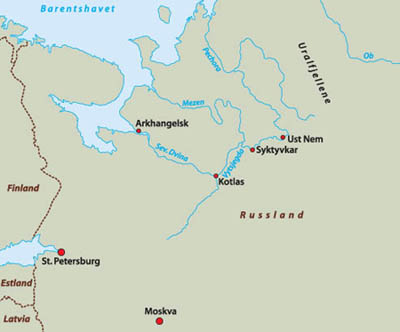During the last Ice Age, the ice dammed enormous lakes in Russia. The drainage system was reversed several times and the rivers flowed southwards. A group of geologists is now investigating what took place when the ice melted and the lakes released huge volumes of fresh water into the Arctic Ocean.
”The ice-dammed lakes in Russia were larger than the largest lakes we know today,” Eiliv Larsen, a geologist at the Geological Survey of Norway (NGU), tells me. He is in charge of the important SciencePub International Polar Year project that is studying natural climate changes in the Arctic and the ways in which man has adapted to them.
Moving glaciers
”The entire drainage system in Russia has been reversed several times during the past 130 000 years. The heavy ice cap covering the land area in the north dammed up lakes and forced the large rivers, the Dvina, Mezen, Pechora and Vychegda, to flow southwards to the Caspian Sea, the Black Sea and on to the Mediterranean,” Eiliv Larsen continues.

However, the ice margin in the north shifted; the ice cap varied in extent, sometimes suddenly advancing eastwards, sometimes retreating. When the plug was released as the ice melted, the water poured from the huge lakes into the Kara Sea and the White Sea, causing the sea level to rise.
The sum total of all these dramatic changes greatly influenced the climate and the circulation in the seas in the Barents Region. SciencePub scientists are trying to find answers to where, when and how often this took place.
Digging down
”We drive vehicles and boats along the large valleys and rivers,” Maria Jensen, a group leader and geologist at NGU, tells me. “Where sediments are exposed along the coast and rivers, we study the sequence of their deposition. It’s here, in the transportation of clay, silt and sand out into the marine system, that we find evidence of the major events,” she points out.
In a cutting beside the River Vychegda, a few kilometres from the village of Ust Nem in the Komi Republic, geologists from Norway, Denmark, Russia and Germany are digging their way down through layers that were deposited during the last Ice Age.
Astrid Lyså, another NGU geologist, explains: ”We remove the outermost layer to get at undisturbed sediments. Then we clean the section, measure it, and photograph, draw and describe the structures in every single layer. We also take samples to date the beds using luminescence, a technique that reveals, for example, when a sand grain was last exposed to the light.”
Reading the history
By investigating a given section, geologists can, for instance, find out what types of deposits are present in the area. They may be moraine, peat, mire, or sediments deposited in the sea, rivers and ice-dammed lakes. The scientists can also find out in which environment these sediments were deposited; was it deep, still or shallow water, beneath the ice, or were the sediments deposited by the wind?
It is thus actually possible to read the history of an ice-dammed lake by studying the succession of layers dug out with a spade, a scraper, a knife and a trowel.
That is precisely what they are doing here at Ust Nem. There seems to have been two ice-dammed lakes here. The patterns of patches of coloured clay and the remains of crushed clay in the sediments suggest, for example, a strong increase in pore pressure and that this particular lake was tapped extremely rapidly.
A big jigsaw puzzle
The scientists are also investigating the landscape around the river, searching for old, dry valleys and small depressions that may explain the drainage system. After driving for just a couple of hours and walking a bit in the forest, they find small valleys which drained into the present course of the river.
The pieces in the jigsaw puzzle are thus gradually falling into place.
”When we fit everything together, we can see the details in and around the enormous lakes which the Russian rivers drained southwards on several occasions and at other times emptied into the Arctic Ocean when the ice melted,” Eiliv Larsen explains.
- Gudmund Løvø




Comments